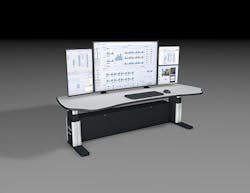Product manager for DeltaV PK Controller and data integration at Emerson
A key challenge for the chemical industry is the time it takes to bring products to market or change operations to accommodate new products. With many process changes, engineers can spend weeks or longer integrating manufacturing skids and their respective automation systems. Working with industry leaders like Emerson, the User Association of Automation Technology in Process Industries (NAMUR) has been developing Module Type Package (MTP) to create a common, open standard that requires less engineering and makes new equipment integration closer to plug-and-play.
Chemical Processing spoke with Emerson’s Juan Carlos Bravo, product manager for DeltaV PK Controller and data integration, to better understand how MTP can standardize and accelerate equipment integration and leverage these benefits to reduce project timelines and costs, improve operations and help the influx of new engineers in the process.
Q: Why does traditional system integration not make sense for today’s trend toward more modular manufacturing? And how will MTP solve that problem?
A: In the past when you built a chemical plant, it was a fixed scope. It was one product, it never moved and it operated for 10 to 20 years. Things have changed and facilities need to produce multiple products. In order to change the process, you need to change the equipment.
Everyone has their own process, their own formula and their own twist. The best way to be nimble is to utilize modular production. The industry came up with the module type package standard. MTP creates a common, open standard that dramatically reduces integration engineering effort. It’s nearly plug-and-play and you can just remove modules or add new ones and you have a different product.
That’s truly the big challenge with traditional systems, they are not equipped for plug-and-play modules. In the past, an engineer would have this big list of signals and have to have conference calls with different OEMs (original equipment manufacturers) and vendors, engineer a plan, and then put it together. If you make changes, that will likely extend the project timeline and increase costs. Instead of spending hours engineering, MTP gives you a file that has a standard configuration and documentation. Load it into a system, and it’s configured.
We’re also extending MTP into active monitoring equipment. So, if you have rotating equipment like a turbine, you can just bring that complex equipment in and connect to the system. Another big benefit is that you don’t need an expert to do this. Someone with very little experience can load a file, go through a wizard and they’re done.
At Emerson, we believe a lot in what we call Human-Centered Design. We test numerous different scenarios and we make sure that the person performing tasks is guided safely through the correct steps to accomplish their goals.
Q: How does flexibility in MTP recommendations provide an opportunity for systems providers to better serve manufacturers?
A: Customers can bring products to market faster. For example, we did a large ethylene cracker project. It was 350 modules with 200 signals each. There were multiple protocols for each module and it took thousands of hours. With MTP, we can reduce this by half because not everything will have to be done manually. It makes system vendors more competitive and customers will reap those benefits as well.
Additionally, by not having to do everything manually, you don’t have engineers who are just doing the minimum because of the crippling workload. You’re bringing more information into a control system that you can reuse for analytics or deep machine learning or for the finance department. In the past you feared performing the engineering to bring in all these elements would overwhelm the system or push the project over budget.
Q: What should organizations consider in order to drive the value gained from MTP beyond project implementation and into everyday operations?
A: One of the bigger benefits of MTP is when you’re building a new plant. With modular manufacturing, you’ll have to switch equipment, calibrate equipment, validate equipment. So, during everyday operations, MTP is going to help you minimize downtime; it will help you change modules faster to help you produce different lines. We enable customers to have a more flexible production line.
Emerson’s MTP-capable products make it easier to unlock modular manufacturing and bring equipment values into the control system.
Q: Are there any challenges?
A: MTP is new in the chemical industry. It was born out of NAMUR in Europe. So, a lot more is happening in Europe. In North America, one of the biggest challenges is we still need to see more vendors adopt it. MTP is still evolving.
Another challenge is it’s not standardized. MTP right now doesn’t have a governing group that validates or certifies MTP vendors or equipment. So, a lot of customers who are adopting it are sticking to a single vendor solution. For example, in Emerson, we support MTP, and we tested our own DCS (distributed control system), our own PLCs (programmable logic controllers) and our own asset monitoring solution (AMS) to ensure that they support all the key elements of MTP and integrate seamlessly.
Q: What about current implementation of MTP?
A: Unfortunately, MTP is so new that there are no full-scale implementations. In Europe a lot of customers are already evaluating and putting equipment in their Greenfield projects. As you know, the pandemic has delayed a lot of these projects. That’s why we haven’t seen much MTP in the field yet. But I know of some customers who are already putting in their specifications where they’re building projects and those vendors who supply MTP were bidding those projects.
Q: Does MTP only benefit integration of PLCs on OEM equipment? Can it be applied to other types of devices typically integrated into the DCS on larger projects?
A: At Emerson, we have also implemented MTP in our asset monitoring equipment. That’s an area where we’re seeing that you need to bring a lot of data into a system to expose information for analytics, for deep machine learning.
For example, there are a lot of pumps in chemical plants. And some of them are critical. If that pump fails, basically it’s going to shut down your production. If MTP connectivity makes it easier to bring pump values into the control system, you can predict that pump is going to fail because it’s showing some vibration, because it’s showing some cavitation – and if you can predict in advance, it’s something that helps the overall productivity.
Q: How can MTP help plants that are struggling to retain a wide base of experienced personnel?
A: There are so few experts now who really know all these protocols. In the traditional project, when you integrate these modules they need to talk different protocols, and some of them are 20-plus-year-old protocols. So, you need to have very experienced people who really know how to map that. There used to be multiple experts on projects to map all these thousands of signals.
Now, with MTP, you can have a more junior engineer do the work because the wizards help map. You can use your experienced people to mentor or work remotely. Or use them in the areas that are critical instead of just doing tedious mapping of modules.
Q: Do you have anything to add?
A: We see signs that MTP is going be widely adopted pretty soon because of the benefits. Right now, the world is in turmoil; customers want and need to be flexible. With supply chain issues, they’re not getting the ingredients they used to get. They need to change their production and change the modules and have a more flexible team.
I think that’s what is different from what we have seen in the past, or at least I have seen in my 20-plusyear career. Sometimes standard adoption takes decades. MTP adoption appears to be going faster, maybe because of the current situation, maybe because of the current mentality or maybe because of the loss of experts. We’re seeing a lot of people retire who are knowledgeable in a lot of these protocols. So, we’re bringing in younger engineers who are used to computer thinking apps. You ask them to map something and they either don’t have the skills to do that mapping or it’s going to take them a while to understand. Vendors like Emerson still have a wide base of people who are knowledgeable and they can transfer and share that knowledge with the next generation by building these wizards. Taking that knowledge and finding a way to share it with the next generation without having to spend hundreds of hours teaching them is truly valuable. So, giving them ways to make the most of what is still in the plants right now while still helping them transition to new technology is really what it’s all about.
For more information, visit: Emerson.com/MTP




